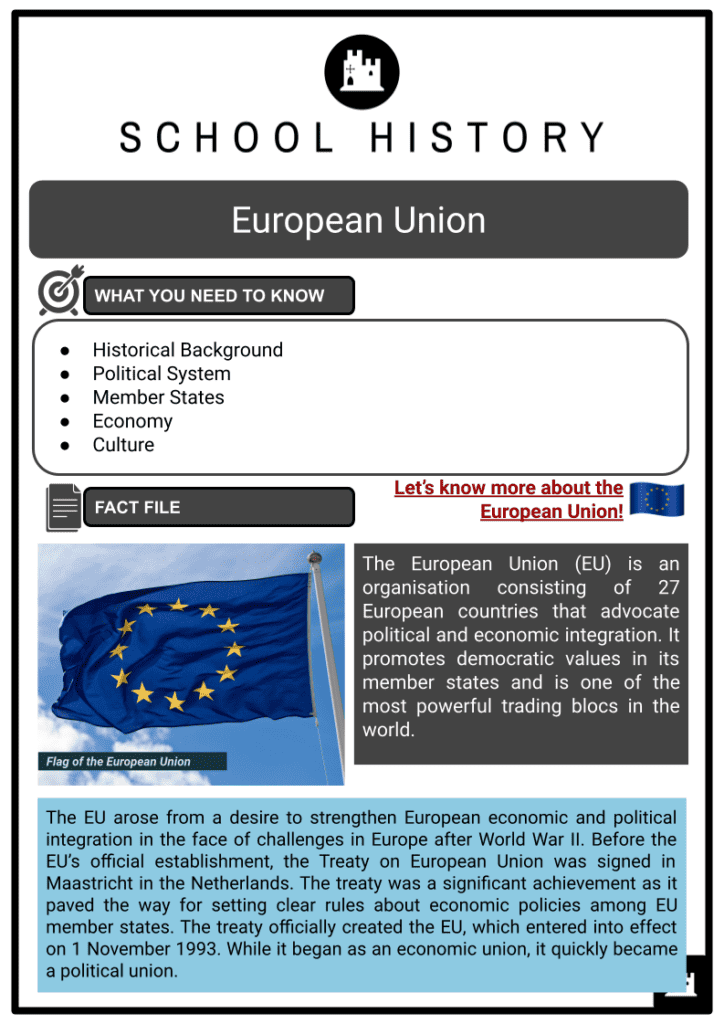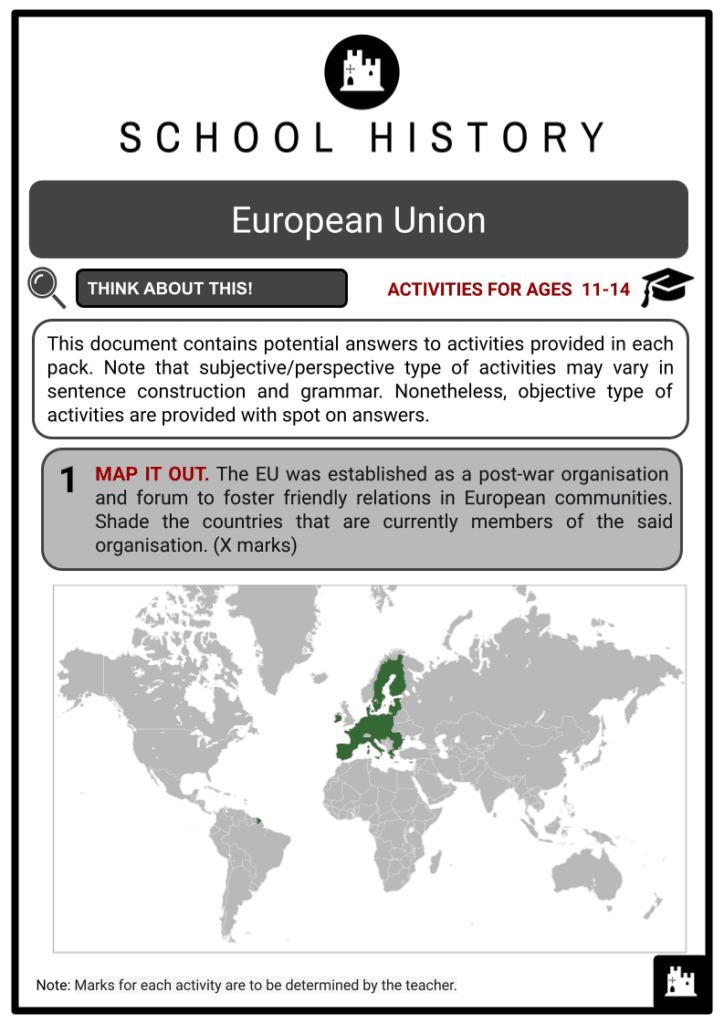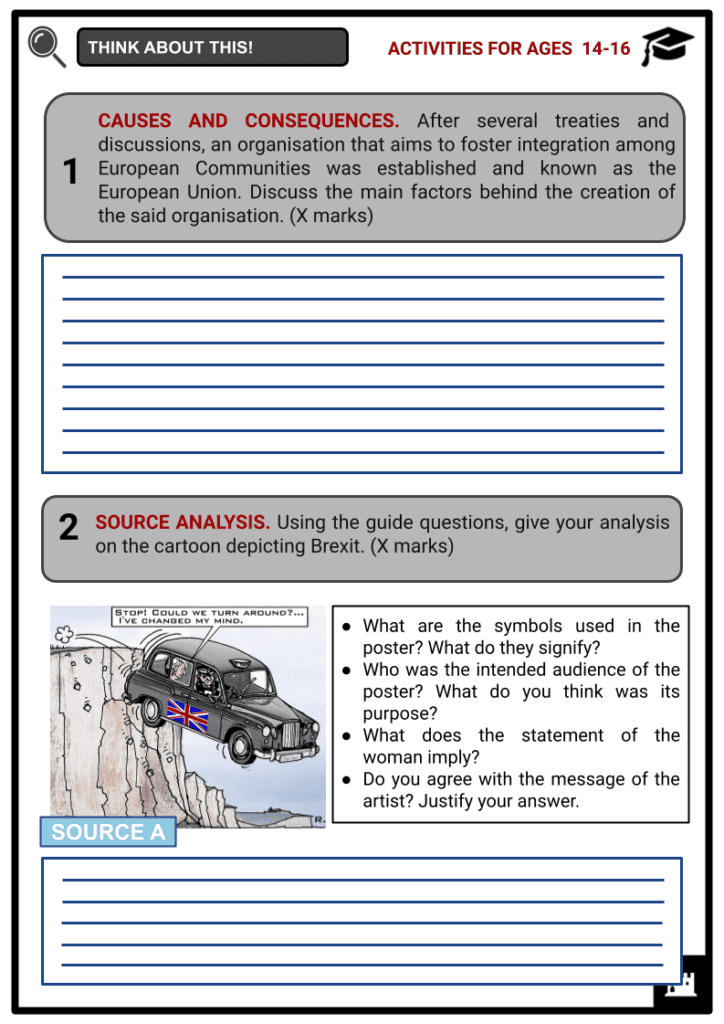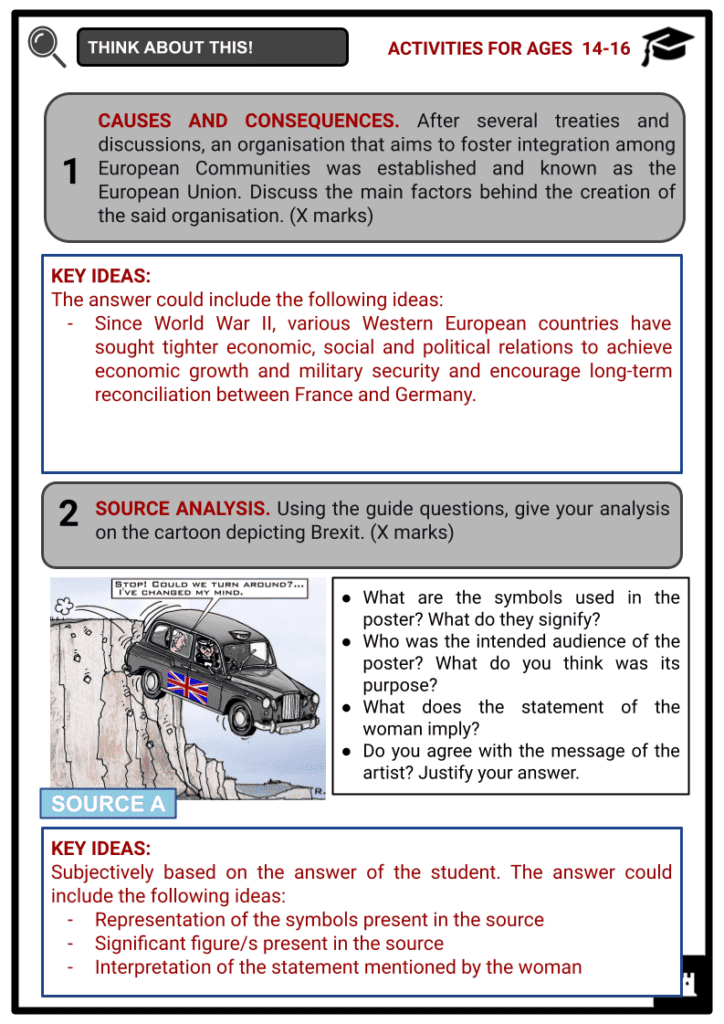European Union Worksheets
Do you want to save dozens of hours in time? Get your evenings and weekends back? Be able to teach about the European Union to your students?
Our worksheet bundle includes a fact file and printable worksheets and student activities. Perfect for both the classroom and homeschooling!
Summary
- Historical Background
- Political System
- Member States
- Economy
- Culture
Key Facts And Information
Let’s know more about the European Union!
The European Union (EU) is an organisation consisting of 27 European countries that advocate political and economic integration. It promotes democratic values in its member states and is one of the most powerful trading blocs in the world. The EU arose from a desire to strengthen European economic and political integration in the face of challenges in Europe after World War II. Before the EU’s official establishment, the Treaty on European Union was signed in Maastricht in the Netherlands. The treaty was a significant achievement as it paved the way for setting clear rules about economic policies among EU member states. The treaty officially created the EU, which entered into effect on 1 November 1993. While it began as an economic union, it quickly became a political union.

HISTORICAL BACKGROUND
- In 1950, French Foreign Minister Robert Schuman offered a strategy for further collaboration. This strategy is commonly known as the Schuman Declaration. He proposed the creation of a European Coal and Steel Community (ECSC), whose members would pool coal and steel production. During this period, nations of Europe were still struggling to overcome the challenges that came about post-World War II. The ECSC's founding members were France, West Germany, Italy, Belgium, the Netherlands and Luxembourg.
- European heads of state began building an organisation that would address these challenges.
- In 1951, the European Coal and Steel Community was founded and served as the first step in securing lasting peace among nations in European Communities. The Treaty of Rome, which is a pillar treaty, created two organisations, namely the European Economic Community (EEC) and the European Atomic Energy Community (EAEC or Euratom) in 1957. The creation of these two organisations led to ever-closer cooperation and integration in Europe.
- March 1958 - Birth of the European Parliament
- The European Parliamentary Assembly, the forerunner of today’s European Parliament, held its inaugural meeting in Strasbourg, France, with Robert Schuman elected as President.
- March 1960 - European Free Trade Association created
- The European Free Trade Association (EFTA) was established to promote economic integration and free trade among countries that were not members of the EEC, including Austria, Denmark, Norway, Portugal, Sweden, Switzerland and the United Kingdom.
- August 1961 - Berlin Wall built
- The communist government in East Germany built a wall across Berlin. It symbolised the separation of Eastern and Western Europe during the Cold War.
- July 1962 - First Common Agricultural Policy
- The first standard agricultural policy gave EEC countries joint control over food production. The policy guaranteed enough food for everyone and that farmers would earn a good living.
- July 1963 - The EEC and its first big international agreement
- The six member countries (Belgium, France, Germany, Italy, Luxembourg and the Netherlands) signed the Yaoundé Convention, which promoted collaboration and trade with 18 former African colonies.
- April 1965 - Signing of the Merger Treaty
- The Merger Treaty united the executives of the three pillar communities (the ECSC, the EEC, and Euratom) and came into effect on 1 July 1967.
- January 1973 - From six to nine member countries
- Denmark, Ireland and the United Kingdom formally joined the European Communities and added to its number of members.
- December 1974 - Reducing disparities between the regions
- EEC leaders agreed to establish a large new fund under European regional policy to demonstrate their togetherness. Its goal was to move funds from wealthy to impoverished areas to build infrastructure, attract investment and generate jobs. The following year, the European Regional Development Fund (ERDF) was established.
- June 1979 - European Parliament and its first direct elections
- For the first time, European citizens directly elected members of the European Parliament. Previously, members were appointed by national legislatures.
- January 1981 - Greece
- Greece joins the European Communities. This membership became legal because democracy was restored in 1974.
- January 1986 - Two new members
- Spain and Portugal become members of the European Communities, bringing membership to 12.
- February 1986 - Towards a single market
- The Single European Act (SEA) initiated a massive six-year effort to sort out economic issues and create a unified market. The legislation, which went into effect on 1 July 1987, also provided the European Parliament (EP) more power and increased the European Communities’ environmental protection authorities.
- November 1989 - Fall of the Berlin Wall
- East Germany opened its doors for the first time in 28 years. The world also witnessed the fall of the Berlin Wall during this year. After more than 40 years, Germany was reunited, and its eastern half entered the European Communities in October 1990.
- February 1992 - Maastricht Treaty
- The Treaty of the European Union was signed in Maastricht. It was a significant milestone because it established explicit principles for the future common currency, foreign and security policy, and tighter collaboration in justice and home affairs. The treaty that created the European Union came into effect on 1 November 1993.
- January 1993 - Launch of the single market
- The single market and its 4 pillars were established:
- free movement of people
- goods
- services and
- money
- The collective agreement established by the founding treaties has evolved pragmatically over time, reflecting the organisation’s structure, the priorities of the many stakeholders in the European integration process, and changes in the geopolitical context.
FOUNDING TREATIES OF THE EUROPEAN UNION
- Single European Act in 1986.The treaties creating the European Communities were amended by the SEA, which established European political cooperation. The title European Parliament became official after the SEA was enacted. The SEA expanded the EP’s legislative powers by instituting cooperation and accession procedures.
- Treaty of Maastricht in 1992On 7 February 1992, the European Union was established by the Treaty of European Union, commonly known as the Maastricht Treaty. The three fundamental pillars of the treaty were:
- the European Communities
- the Common Foreign and Security Policy (CSFP)
- Justice and Home Affairs (JHA)
- Treaty of Amsterdam in 1997In March 1996, an intergovernmental conference (IGC) was convened in Turin to revise the Treaty on European Union. The subsequent Treaty of Amsterdam was signed in the presence of José Mara Gil-Robles, President of the European Parliament.
- Treaty of Nice in 2001The Treaty of Nice aimed to modernise the EU’s institutional framework to meet the challenges of the enlargement at that time.
- The EU’s uniqueness stems from the unique method by which its constituent parts have evolved. The establishment of the EU in 1993 brought together the European Communities in integrating their activities to attain the foreign standard and security policy – considered as the two intergovernmental areas of integration. Since then, many nations have joined the EU, intending to integrate economically and politically.
- The EU is considered the first international body to be formed not by coordinating the national policies of its members but by pooling some of those policies under the European Communities. As a result of the voluntary transfer of certain sovereign powers by its member states, the EU became a supranational organisation.
- Member states did not give up their powers. Instead, they agreed to use them at a higher level with shared institutions. Integration has proceeded step by step to establish a close union among the people in European countries, first by pooling policies on specific sectors of member states’ national economies, then by creating a common market, followed by the gradual introduction of an economic and monetary union.
- Regardless of its economic roots, the goal of the EU was always political. Jean Monnet, a French politician and economic adviser, was a lifelong supporter of European integration, whose ideas inspired the Schuman Plan to unite French and German national coal and steel production under a single banner.
- Jean Monnet and Robert Schuman were considered the founders of the European Communities. They took a functional approach that indicated a shift from the economic to the political domain of the predecessors of the EU.
- According to Monnet and Schuman, specific activities in one area of the economy were sure to affect how other sectors functioned.
- Monnet and Schuman’s conclusion was true of social and fiscal policies of the EU. The organisation’s internal policies had outward repercussions that it had to manage as an entity under international law in its interactions with non-member states and other international organisations. As a result, foreign ties were developed in sectors such as global trade, development aid, immigration, defence, and so on.
- The year 2001 was a crucial year for countries all over the world when New York and Washington experienced a terrorist attack. With this, the governments of different countries rallied to fight terrorism and aimed to protect their territories by cooperating. In the subsequent years, the EU gained more member states.

EU bank notes - January 2002 - Coins and euro notes launched in 12 countries
- Coins and euro notes became legal tender in 12 EU nations (Greece entered the eurozone in 2001, and more countries joined in 2002).
- May 2004 - Ten countries joined the EU
- Cyprus and Malta joined the EU, along with eight Central and Eastern European countries — Czechia, Estonia, Hungary, Latvia, Lithuania, Poland, Slovakia and Slovenia — ending Europe’s partition after WWII.
- May - June 2005 - EU constitution was established
- Voters in France and the Netherlands rejected the treaty establishing a European Constitution, which the EU’s 25 member states agreed to in October 2004.
- January 2007 - Bulgaria and Romania joined the EU
- Bulgaria and Romania in Eastern Europe joined the EU, which now consisted of 27 member states.
- July 2013 - Croatia joined the EU
- Croatia joined the EU in 2013, which made it the 28th member state.
POLITICAL SYSTEM
- The EU has a confederal political structure, with many policy areas federalised into common institutions capable of making law. Foreign policy, defence policy, and the majority of direct taxation policies are generally reserved for the 27 state governments (the union does limit the extent of variance permitted for Value Added Tax or VAT).
- The Treaty System underpins the EUs democratic legitimacy. The European Community has two treaties as its legal foundation: the Treaty of Rome and the Treaty of Maastricht.
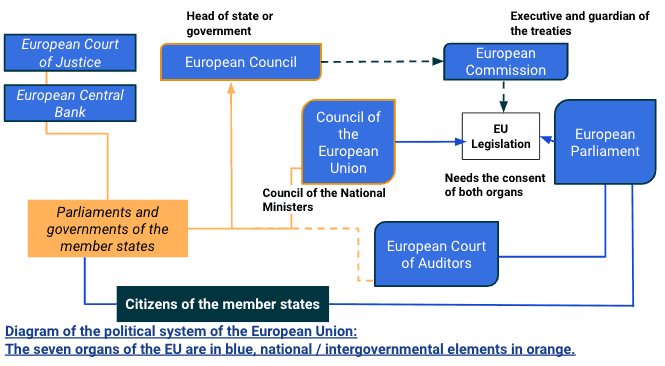
- The repeated treaty amendments and modifications have resulted in a patchwork of policy and planning, contributing to the EU’s complex structure. The EU’s constitutional foundation is a combination of treaties with no singular actualising government charter. Opponents see this ambiguity as a critical source of the democratic deficit.
- The EU is a legal personality as well as a group of governing entities empowered by treaties. However, sovereignty is shared by rather than invested in those institutions, with ultimate sovereignty resting with state governments. But, in those areas where the EU has been granted competence, it has the authority to impose binding and direct laws on its members.
- The union's operation will be based on representative democracy. The EP represents citizens directly at the Union level. Member states have representation in the European Council by their heads of state or government, and governments are represented in the Council by their governments, which are democratically accountable to their national legislatures or constituents. Every person has the right to participate in the union's democratic life. Decisions must be made as freely and transparently as feasible. Political parties at the European level help to shape European political awareness and represent the will of union citizens. - Article 10 of the Treaty on European Union
- The formal and main legislative procedure of the European Union is the Ordinary Legislative Procedure (OLP). The Treaty of Maastricht’s co-decision norm, and the subsequent Treaty of Lisbon, eventually gave the European Parliament and the European Council (EC) equal weight and established the OLP as the primary legislative mechanism.
- In 2009, the Treaty of Lisbon amended the old Treaties of Rome and Maastricht, updating the EU's constitutional foundation. The Treaty of Lisbon made significant changes, including establishing a long-term President of the EC, recognising the EC as an official EU institution, and introducing a new job of High Representative for Foreign Affairs and Security Policy.
FOUR TYPES OF RULING IN THE ORDINARY LEGISLATIVE PROCEDURE
- REGULATIONS
- DIRECTIVES
- DECISIONS
- RECOMMENDATIONS
- The EP and the EC have equal weight in making decisions. Regulations are automatically binding on all member states. Directives bind all member states, but the execution is left to national courts in a process known as transposition.
- However, because member states set their own transposition timelines, there is a democratic deficit between states. Non-state litigants whose decisions are directed are bound by the EP and EC. Recommendations, like views, are non-binding and designed to inform legal decisions.
MEMBER STATES
- There are 27 member states that have delegated authority to the EU institutions. In exchange for granting competencies, EU nations are given Council votes, seats in Parliament and a European Commissioner, among other things. Member states’ internal governments range between presidential systems, monarchies, federations and microstates. Nonetheless, all members must adhere to the Copenhagen criteria of democracy, human rights and a free market economy.
- The United Kingdom, which joined the EU’s forerunner in 1973, ended its membership on 31 January 2020. No other member states have withdrawn or been suspended from the EU, though some dependent territories or semi-autonomous areas have. Some member states are not part of the EU in certain areas, such as the eurozone, which has only 20 of the 27 members, and the Schengen Agreement, which currently has only 23 EU members. A number of nations outside the EU participate in EU initiatives, such as the euro, Schengen, the single market and defence.
- The eurozone (EZ) is a currency union of 20 European Union member states who have embraced the euro (€) as their principal currency and exclusive legal tender, and have therefore fully implemented economic and monetary union (EMU) regulations. The EMU is a set of policies aimed at connecting the economies of all member states of the EU.
- The Schengen Agreement is a treaty that established Europe’s Schengen Area, which consists of 27 European countries with largely eliminated internal border checks for short-term tourist and business travel, or transit to non-Schengen destinations.
- According to the Copenhagen criteria, membership of the EU is open to any European country with a stable, free market and liberal democracy that respects the rule of law and human rights. Furthermore, it must be willing to accept all membership obligations, such as adopting all previously agreed-upon rules and switching to the euro.
- The Copenhagen criteria are the parameters that determine whether a country qualifies for membership of the EU. These membership criteria were established at the EC in Copenhagen, Denmark, in June 1993.
- There is no mechanism for expulsion, although Article 2 of the Treaty on European Union allows for the suspension of some rights. Article 7 of the Treaty of Amsterdam states that if a
- member consistently violates the EU’s founding principles (liberty, democracy, human rights, and so on, as outlined in Treaty on European Union Article 2), the EC can vote to suspend any membership rights, such as voting and representation.
- Prior to the Treaty of Lisbon, no mechanism or procedure existed in any of the European Union’s treaties that enabled a member state to exit from the European Union or its precursor institutions. This was amended by the Treaty of Lisbon, which established the first mechanism and procedure for a member state to quit the bloc.
- As of 2023, the UK is the only former member state to have exited the EU. Following a referendum in June 2016, the UK’s government formally began the procedure of the UK’s withdrawal from the EU by citing Article 50 of the Treaty on European Union.
- While member states are sovereign, the union partially adheres to a supranational system for those functions agreed to be shared by treaty. Previously limited to EC matters, the community method is now used in a wide range of policy areas.
- Article 4 says that powers not granted to the union by the Treaties belong to the member states.
- The union shall respect member states' equality before the Treaties and their national identities, which are inherent in their core political and constitutional frameworks, including regional and local self-government. It must uphold its core state functions, such as ensuring the state's territorial integrity, upholding law and order, and protecting national security. National security, in particular, remains solely the responsibility of each member state. - Excerpt from the Article 4 of the Treaty on European Union
BREXIT
- ‘Brexit’ was the term used for the withdrawal of the UK as a member of the EU on 31 January 2020. The UK is the only sovereign country that has quit the EU. The UK had been a member of the EU since 1 January 1973. Except in Northern Ireland, European Union law and its Court of Justice no longer take precedence over British law following Brexit.
- During his 2015 election campaign, Prime Minister David Cameron promised to hold a referendum on Britain’s EU membership in response to criticism from eurosceptics within his own party and to prevent more defections to Nigel Farage’s (a British broadcaster and former politician who was Leader of the UK Independence Party) UKIP party. Cameron attempted to renegotiate Britain’s EU membership terms prior to the referendum.

Map representation of Brexit. The UK in orange, the European Union in blue. - Some of Cameron’s requests were granted, including reimbursing the UK for money spent on eurozone bailouts, exempting the UK from the EU’s ever-closer union obligation, and allowing Britain to avoid paying social benefits for migrant workers who had been in the country for less than seven years.
- The UK refused to yield on matters like immigration, sovereignty and anti-establishment politics.
- Furthermore, the Brexit campaign successfully linked this worry to the regaining control concept from the EU. This argument resonated with nationalist sentiments among older voters, those concerned about excessive EU rules and environmental standards, and those who feared that EU laws and regulations threatened British sovereignty.
- The Brexit campaign also claimed that the UK was a net donor to the EU budget, claiming that by leaving the EU, the UK could spend an extra £350 million on the National Health Service (NHS), as Boris Johnson revealed in an exclusive interview with The Guardian.
“There was an error on the side of the bus. We grossly underestimated the sum over which we would be able to take back control.”
ECONOMY
- The European Union economy is the combined economy of the EU’s member states. It has the world’s third-largest nominal economy, after the United States and China, and the world’s third-largest purchasing power parity (PPP) economy, after the United States and China.
- According to a report mentioned in the ‘Report for Selected Country Groups and Subjects’ by the International Monetary Fund (IMF), the gross domestic product (GDP) of the EU exceeded $16.6 trillion (nominal) in 2022, accounting for around one-sixth of the world economy. Germany has the highest national GDP of any EU country, followed by France and Italy.
EUROZONE AND BANKING UNION
- The currency union began to take shape in 1999, introducing a common accounting (virtual) currency in 11 member states. It became a fully fledged convertible currency in 2002 when euro notes and coins were produced, and the phaseout of national currencies in the eurozone (consisting of 12 member states at the time) began.
- The European Central Bank (ECB) is the eurozone’s central bank and conducts monetary policy in that region to maintain price stability. It is at the centre of the Eurosystem, which comprises all the eurozone national central banks. The ECB is also the central institution of the Banking Union established within the eurozone and manages its Single Supervisory Mechanism.
LABOUR
- The free movement of people means that EU individuals can freely migrate between member states to live, work, study or retire. This necessitated the reduction of administrative requirements as well as the acknowledgement of professional degrees from other jurisdictions.
- Working Time Directive is a European Union legislation directive that is an essential component of European labour law. It grants EU workers the following rights:
- employees are entitled to at least 28 days (four weeks) of paid holiday every year
- 20-minute rest periods every 6 hours
- a daily rest period of at least 11 hours in any 24-hour period
- limits late-night work
- at least 24 hours of rest in 7 days
- a right to work up to 48 hours a week unless the member state allows individuals to opt out
- The reduction of administrative requirements and the acknowledgement of professional degrees from other jurisdictions have passed legislation establishing minimum employment and environmental requirements for that purpose. The Working Time Directive and the Environmental Impact Assessment Directive were among them. The EP enacted the Minimum Wage Directive in September 2022 to raise minimum wages and strengthen collective bargaining.
SOCIAL RIGHTS, FREEDOM AND JUSTICE
- The EU has also sought to coordinate member states’ social security and health systems to facilitate individuals exercising free movement rights and to ensure they can access social security and health services in other member states. Since 2019 there has been a European commissioner for equality, and the European Institute for Gender Equality has existed since 2007.
- Article 2 of the Treaty of Amsterdam states that discrimination prohibitions have a long history in treaties. These have recently been supplemented with the authority to pass legislation against harassment based on race, religion, disability, age or sexual orientation.
- The 2009 Treaty of Lisbon provided legal force to the EU’s Charter of Fundamental Rights. The charter is a codified inventory of fundamental rights that can be used to judge the EU’s legal acts. It codifies several rights previously recognised by the Court of Justice and stemmed from constitutional traditions common to the member states.
- Despite their shared goals and beliefs, the EU is independent of the Council of Europe, particularly on the rule of law, human rights and democracy. The Council of Europe also created the European Social Charter and the European Convention on Human Rights, serving as the legal foundation for the Charter of Fundamental Rights.
CULTURE
- Since culture has been included as a common capacity in the Treaty of Maastricht, the EU has been interested in cultural cooperation among member states. The EU’s cultural initiatives include:
- The seven-year Culture 2000 programme.
- European Union Youth Orchestra.
- The European Cultural Month event.
SPORT
- Sport is mostly the responsibility of individual member states or other international institutions, not the EU. Some EU regulations have impacted the sport, such as the free movement of labour, which was at the heart of the Bosman judgement, which prevented national football leagues from setting quotas on international players with EU citizenship.
SYMBOLS
- The European flag is a circle of 12 golden stars on a blue backdrop. Originally designed for the Council of Europe in 1955, the flag was adopted in 1986 by the European Communities, the predecessors of the current EU.
MEDIA
- According to Maria Poptcheva, a Spanish politician who has been a Member of the European Parliament for the Citizens–Party of the Citizenry since 2022 in her Press freedom in the EU Legal framework and challenges, media freedom is a fundamental right that applies to all EU member states and their citizens, as specified in both the European Convention on Human Rights and the European Union Charter of Fundamental Rights.

